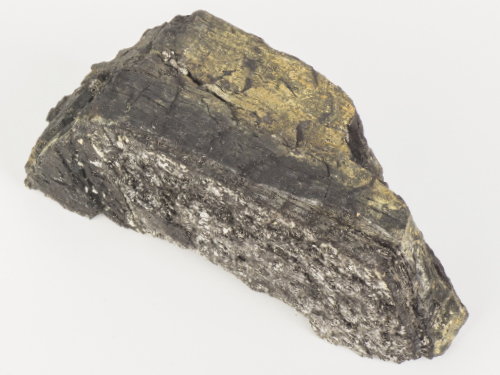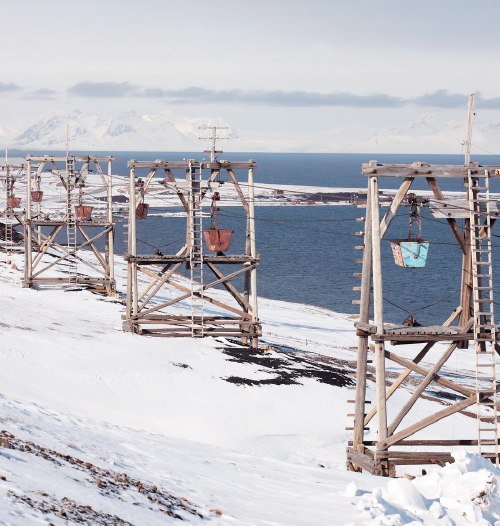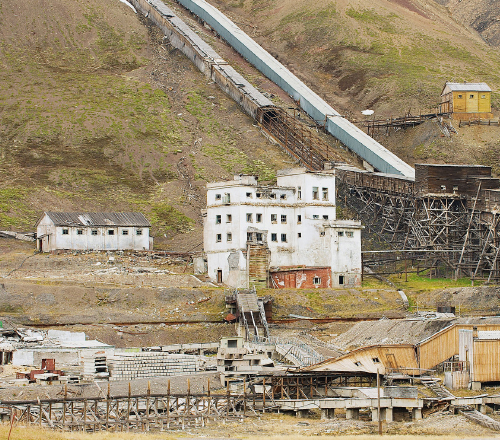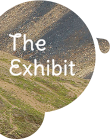Mining Coal in the Arctic

The Arctic icecap is rapidly changing shape as it loses ice and breaks temperature records. There is widespread agreement that this change is a result of increased human economic activity since the Industrial Revolution, particularly the burning of fossil fuels, which has released significant amounts of carbon dioxide, a greenhouse gas, into the atmosphere.
On the subject of fossil fuels, chunks of coal can be seen in the glass cabinet in the Jockey Club Museum of Climate Change. They are coal samples from Svalbard, a Norwegian archipelago in the Arctic Ocean, and were collected by Dr Rebecca Lee in one of her many visits to the Arctic. The irony that lies behind these samples is often remarked upon by visitors to the museum. They are testament to an activity, coal mining, that has for long been the only source of income for most inhabitants on Svalbard and has kept the archipelago alive. At the same time, the extravagant use of coal and other fossil fuels as a source of energy in recent decades has driven global climate change and the retreat of the Arctic icecaps and sea ice.

Svalbard has the world’s most northerly coal mines. Mining was responsible for the first settlements on this inhospitable island in the 1920s, and although its profitability is much lower than it used to be, mining remains the island’s main industry to this day. Of the many mines that used to operate on Svalbard, only two are still being worked: one by a Norwegian company in Longyearbyen and the other in Barentsburg, a company town developed by a Russian mining company. For both Norway and Russia, these remote settlements provide a useful strategic foothold in the Arctic region, or they would long ago have been abandoned. As the price of coal continues to plummet while cleaner energy alternatives become more attainable, Svalbard’s mining settlements are trying to transform themselves into tourist destinations. Longyearbyen also hopes to become a scientific research hub.
Most of the world’s coal seams were formed 360–330 million years ago in the Early Carboniferous Period. Coal seams of this age on Svalbard were mined in Pyramiden until 1998 by the Russians. Although a number of coal occurrences of varying ages have been reported on Svalbard, the youngest seams are economically more important and are now being worked in Longyearbyen and Barentsburg. These youngest coal seams were formed about 60 million years ago in the Early Tertiary Period, when the climate was generally warmer than today.

They developed mainly in terrestrial environments, by the accumulation of deciduous plants in low-lying flatlands with forests, bogs and rivers that were periodically flooded, compared to the older, Carboniferous coal seams formed from ferns in humid, tropical swamps when Svalbard was situated in the tropical zone north of the equator. In these wetlands and swamps, plant debris was buried under layers of mud and sand under anoxic or low-oxygen conditions, which protected the debris from the air and slowed down the decomposition process. Under the weight of the overlying sediments, the plant debris was subjected to increasing levels of temperature and pressure, and was eventually compacted and transformed into coal.
During the process of coal formation, the hydrocarbon components so formed retained a significant proportion of the chemical energy imparted into the original living organisms by the sun. By using this energy today, we release into the atmosphere, in the form of carbon dioxide, ancient hydrocarbons that have been safely stored below ground for hundreds of millions of years. The release of these high volumes of carbon dioxide is a major driver of global warming, and is largely responsible for its deleterious effects on our oceans.
References
- Robb, L. (2012). Introduction to Ore-forming Processes. Blackwell Publishing.
- Filipova, A. and Dickerman, K. (2017, June 28). What it’s like in the cold, dark, isolated coal mines of the Arctic. The Washington Post. Retrieved from https://www.washingtonpost.com/news/in-sight/wp/2017/06/28/what-its-like-in-the-cold-dark-isolated-coal-mines-of-the-arctic/?utm_term=.246287054596.
- Stange, R. (2014, October 28). Adventfjord-Longyearbyen. Retrieved from https://www.spitsbergen-svalbard.com/spitsbergen-information/islands-svalbard-co/isfjord/adventfjord-longyearbyen.html.
- Stange, R. (2013, October 11). Mining. Retrieved from https://www.spitsbergen-svalbard.com/spitsbergen-information/history/mining.html.








